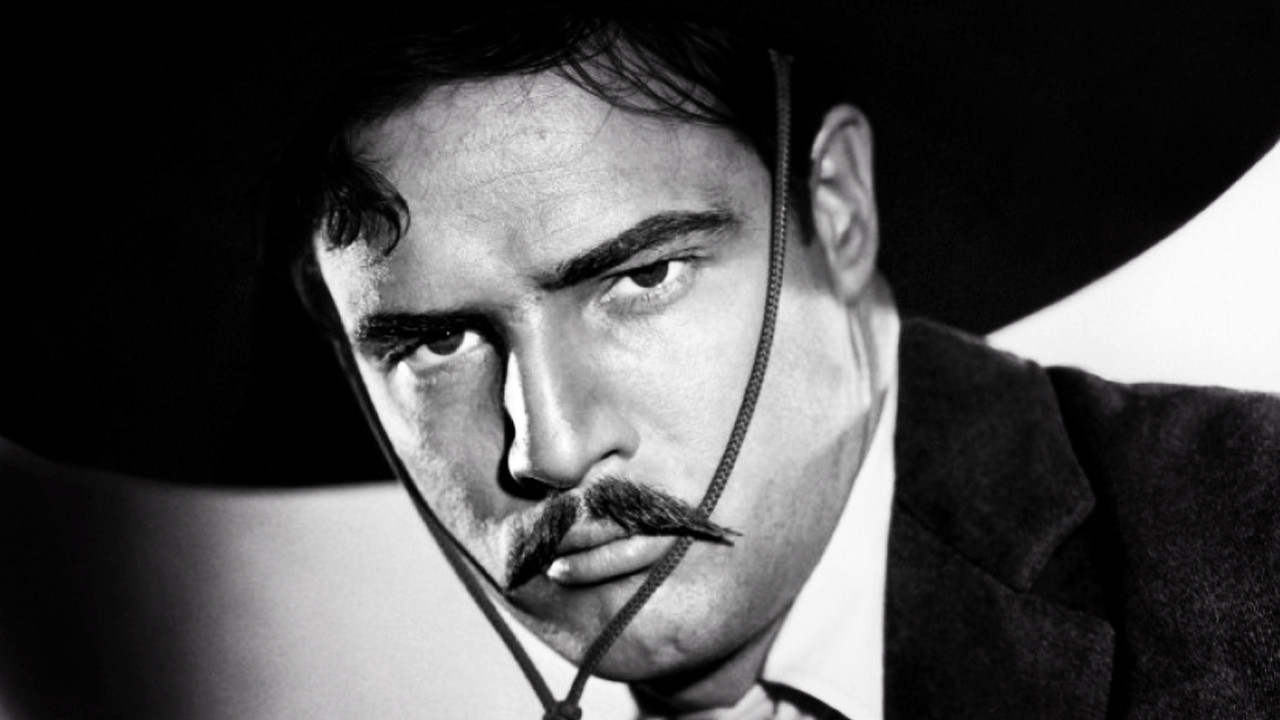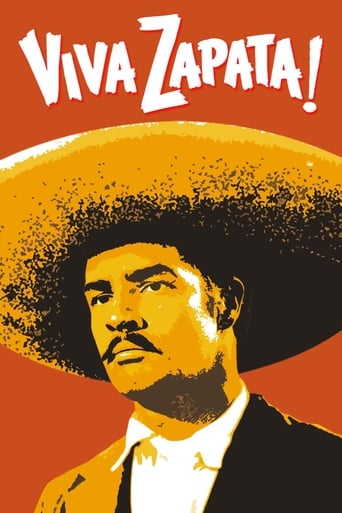

This is what we should still be protesting for the whitewashing. Not just because it blows away every bit of the culture they were fighting for, but because its so badly done. Marlon Brando and Anthony Quinn, especially, sound like Marlon Brando and Anthony Quinn. Not a sliver of acting in most scenes. Plus overbearing music, a title card because exposition is for suckers, hamhanded editing, the occasional awful soundstage cut, an awful lot of focus on Zapata appealing to the upper classes and getting distracted by his girlfriend's family, etc. etc. Just awful head to toe. Surprised this talent could make a movie this bad, and I do not get why anyone would like it. Baffling.
... View MoreAt first he doesn't look much like we remember him - Marlon Brando appears as his Mexican Emiliano Zapata with a stern face at the Mexico Priesidente demanding, simply, land rights and making sure boundaries can be drawn. His name is circled on the President's desk, not a good sign, and from here on in Zapata is fighting and fighting (what one character says is as simple as it is - it's all he knows) so that the farmers can have their land, as opposed to time and patience, to grow their corn with.When Brando first appears as this revolutionary figure he doesn't quite look like himself, and at the same time does very much, and it's disarming. I didn't buy it entirely in the first scene... and then the scenes kept coming, and Brando, playing Zapata as stubborn and headstrong and without much in way of a sense of humor as a leader as a General (and rightfully so as revolutionary figures tend to be, see Che for more details), is spot on. It's worthy of the rest of his oeuvre at the time, if not quite up to the monolithic status of Streetcar and Waterfront then at least as good if not better than the underrated The Wild One. This is vintage Brando every step of the way, absorbing us in this figure who reminds us all why it's necessary to have such heroes - but also the lacerating side of the double-edged sword where-in those in power will do all they can to destroy the hero. That and, well, revolutions and movements of ideas amongst people end up turning things pretty damn bittersweet; just look at the very end for that, as four peasants talk of Zapata's status as an idea as well as a man.Viva Zapata! presents Mexico in some fresh and amazing cinematography, sturdy and sometimes clever and heartfelt direction from Elia Kazan, always best with his actors (even Anthony Quinn who again proves why he was best as taking on an ethnicity and making it believable, if only up to a point as his powerhouse turn shows here), and some very interesting writing from John Steinbeck. The script sometimes takes its turns and movements that don't make it quite flow as well as it would in a book; individual scenes are knock-outs, mini-masterpieces of words exchanged with underlying meaning or trying to find the meaning in how people can persevere, or not as it turns out (one such scene I loved is when Zapata has been installed as the President- as Pancho Villa says there's "no one else"), and the farmers he says he knows comes and demands the same things he did once before, but at a personal price.There's lots of great things like that, or just the uncomfortable but true rapore between Zapata and his future-wife's family when they talk in metaphors. If only Steinbeck didn't sometimes jerk the story ahead without some warning (it will be hard to explain, you just have to see it to understand, though this may have more to do with the direction than writing, more research is needed for this assumption) it would be unstoppable as a classic. As it stands though Viva Zapata! is an essential chronicle of a rebel with a cause, an honest man of principles who tried to do too much good in a country where it just wasn't possible. Or, perhaps, things like this just aren't possible; one can see the parallels and maybe even find this to be like a condensed version of Soderbergh's Che in taking a sobering look at the sweet highs and sobering lows of rising up against the powers that be (and yes, this is quite the leftist movie, all the more odd considering it's John McCain's favorite film!)
... View MoreThere are some good things about this movie. There's a reflection on what can so easily happen to a revolutionary movement when it takes power, as Madero (Harold Gordon) betrays the people he supposedly fought for by not pursuing land reform after he becomes president of Mexico; there's a very moving and eloquent speech by Zapata (Marlon Brando): "if they take your corn, grow more; if they kill your children, breed more," etc., etc.; there's the reflection contained at the end of the movie when it becomes clear that to kill a man does not kill the ideas the man represented. So, in terms of political commentary, there's a lot of good stuff here. There was also a pretty good performance from Brando, who portrays Zapata as brooding and sombre throughout - a man who finds little time to enjoy the pleasures of life (even his beautiful bride) because he spends so much time fighting for the people. It was a good portrayal.Unfortunately, that powerful content is submerged in a movie that is often, to be blunt, quite dull and actionless, with a number of scenes throughout in which very little happens. Twice I sat down to watch it; both times I missed part of it because it put me out. Through both watchings, I think I've seen the whole thing, but that says something to me. In all honesty, the movie lost me somewhat right off the top when my initial impression of what I was seeing was that it was a bunch of American actors running around in sombreros pretending to be Mexican. It lacked authenticity to me. (Fay Roope as Porforio Diaz was especially unconvincing.) That made it hard for the movie to maintain my attention, even given the strong parts that I've mentioned. I end up rating this as a 3/10, still noting that the strong content is diluted by what I found to be an overall unengaging story.
... View MoreAll great ideas are lonely and in minor,life is pure compromise...unfortunately.This is a tragic of this world full of compromises,where no big vision could fit in.Nowhere.And this is point of this,a truly master-piece movie.I have just read somewhere that Brando accidentally swallowed his brown contact lenses during the production and to admit it I laughed a lot.What a King!!! I bet that working with him was truly an adventure.Quinn is also a really great actor.Although his face is more suitable for roles of Spanish and Arabian characters,he could rush at some other as well.Spectacular moment in this film is certainly that white horse,a symbol of many,not just Zapata.Symbol of all great people fighting for great ideas.At every step we could see that white horse,guiding his way to eternity...VIVA BRANDO!!!..and of course VIVA ZAPATA!!!
... View More